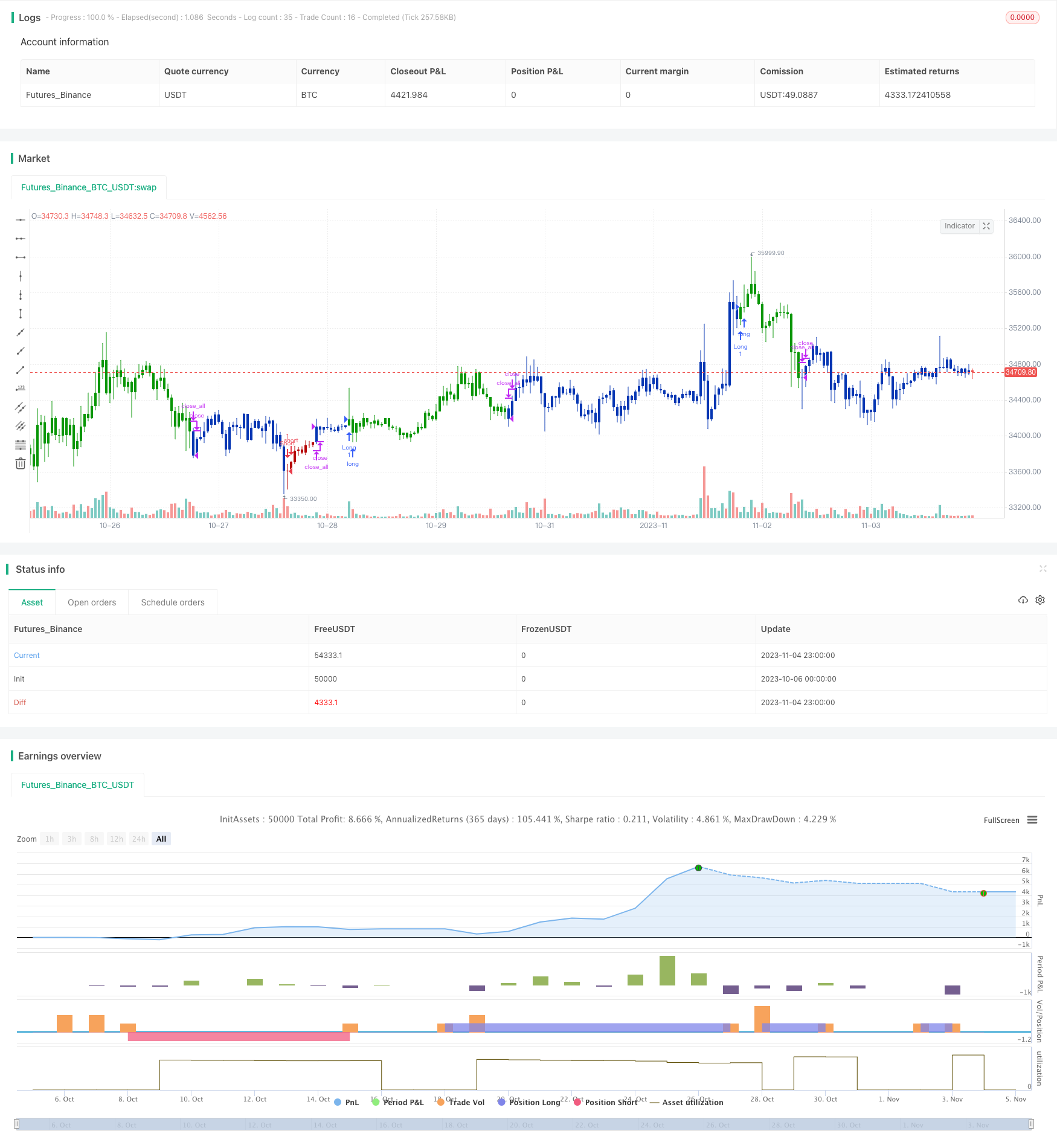
概述
该策略是将反转策略与动量指标结合使用的组合策略。它整合了双向反转策略和香氏动量震荡器,旨在发现反转机会的同时验证动量信号,实现更可靠的交易信号。
策略原理
该策略由两部分组成:
第一部分是双向反转策略。它通过检测前两天的收盘价变化来判断反转机会。具体来说,如果前两天收盘价递减,当天收盘价较前一天收盘价上涨,且随机指标低于设定水平,则为买入信号。相反,如果前两天收盘价递增,当天收盘价较前一天收盘价下跌,且随机指标高于设定水平,则为卖出信号。
第二部分是香氏动量震荡器。它通过比较价格变化量与一定周期内的平均变化量大小来判断动量。如果动量指标高于设定上限,为买入信号;如果低于设定下限,为卖出信号。
该策略综合运用双向反转判断反转点和动量指标验证动量情况,只有两者信号同向时,才会产生实际的买入卖出信号。
策略优势
双重验证机制,避免虚假信号,提高信号的可靠性。反转策略判断潜在反转点,动量指标验证反转信号的有效性。
反转策略与趋势策略相结合,兼顾反转和趋势,灵活捕捉市场机会。
引入动量指标,避免反转陷阱,仅在动量确认时交易。
多种参数可调,可针对不同市场进行优化。
策略风险
反转信号可能出现回调深度大,需要合理止损。
反转时点捕捉需要精准,可能出现误判。
动量指标产生滞后,可能错过最佳反转时点。
参数设置需要根据具体市场谨慎优化,不当设置可能增加交易风险。
可通过合理止损来控制单笔损失。优化参数设置,追求参数稳健性。适当宽松反转信号触发条件,保留一定余地等方法来降低风险。
策略优化方向
测试不同反转参数组合,寻找对市场反转的敏感参数设置。
尝试不同动量指标,如相对强弱指数、成交量变动率等。
添加过滤条件,如突破,避免非关键反转点的交易。
评估止损策略,寻找最大回撤可控的止损方法。
评估仓位控制策略,根据市况调整仓位大小。
总结
该策略融合反转策略和动量策略的优点,具有信号可靠性高、灵活捕捉市场机会的优势。通过参数优化、止损管理、仓位控制等方法可以降低风险,提高策略稳定性和盈利能力。总体来说,该策略开创性地探索了反转策略与趋势策略的有效结合,值得进一步研究和应用。
/*backtest
start: 2023-10-06 00:00:00
end: 2023-11-05 00:00:00
period: 1h
basePeriod: 15m
exchanges: [{"eid":"Futures_Binance","currency":"BTC_USDT"}]
*/
//@version=4
////////////////////////////////////////////////////////////
// Copyright by HPotter v1.0 18/08/2019
// This is combo strategies for get a cumulative signal.
//
// First strategy
// This System was created from the Book "How I Tripled My Money In The
// Futures Market" by Ulf Jensen, Page 183. This is reverse type of strategies.
// The strategy buys at market, if close price is higher than the previous close
// during 2 days and the meaning of 9-days Stochastic Slow Oscillator is lower than 50.
// The strategy sells at market, if close price is lower than the previous close price
// during 2 days and the meaning of 9-days Stochastic Fast Oscillator is higher than 50.
//
// Second strategy
// This indicator plots Chande Momentum Oscillator. This indicator was
// developed by Tushar Chande. A scientist, an inventor, and a respected
// trading system developer, Mr. Chande developed the CMO to capture what
// he calls "pure momentum". For more definitive information on the CMO and
// other indicators we recommend the book The New Technical Trader by Tushar
// Chande and Stanley Kroll.
// The CMO is closely related to, yet unique from, other momentum oriented
// indicators such as Relative Strength Index, Stochastic, Rate-of-Change,
// etc. It is most closely related to Welles Wilder`s RSI, yet it differs
// in several ways:
// - It uses data for both up days and down days in the numerator, thereby
// directly measuring momentum;
// - The calculations are applied on unsmoothed data. Therefore, short-term
// extreme movements in price are not hidden. Once calculated, smoothing
// can be applied to the CMO, if desired;
// - The scale is bounded between +100 and -100, thereby allowing you to
// clearly see changes in net momentum using the 0 level. The bounded scale
// also allows you to conveniently compare values across different securities.
//
// WARNING:
// - For purpose educate only
// - This script to change bars colors.
////////////////////////////////////////////////////////////
Reversal123(Length, KSmoothing, DLength, Level) =>
vFast = sma(stoch(close, high, low, Length), KSmoothing)
vSlow = sma(vFast, DLength)
pos = 0.0
pos := iff(close[2] < close[1] and close > close[1] and vFast < vSlow and vFast > Level, 1,
iff(close[2] > close[1] and close < close[1] and vFast > vSlow and vFast < Level, -1, nz(pos[1], 0)))
pos
CMO(Length, TopBand, LowBand) =>
pos = 0
xMom = abs(close - close[1])
xSMA_mom = sma(xMom, Length)
xMomLength = close - close[Length]
nRes = 100 * (xMomLength / (xSMA_mom * Length))
pos := iff(nRes > TopBand, 1,
iff(nRes <= LowBand, -1, nz(pos[1], 0)))
pos
strategy(title="Combo Backtest 123 Reversal & Chande Momentum Oscillator", shorttitle="Combo", overlay = true)
Length = input(14, minval=1)
KSmoothing = input(1, minval=1)
DLength = input(3, minval=1)
Level = input(50, minval=1)
//-------------------------
LengthCMO = input(9, minval=1)
TopBand = input(70, minval=1)
LowBand = input(-70, maxval=-1)
reverse = input(false, title="Trade reverse")
posReversal123 = Reversal123(Length, KSmoothing, DLength, Level)
posCMO = CMO(LengthCMO, TopBand, LowBand)
pos = iff(posReversal123 == 1 and posCMO == 1 , 1,
iff(posReversal123 == -1 and posCMO == -1, -1, 0))
possig = iff(reverse and pos == 1, -1,
iff(reverse and pos == -1 , 1, pos))
if (possig == 1)
strategy.entry("Long", strategy.long)
if (possig == -1)
strategy.entry("Short", strategy.short)
if (possig == 0)
strategy.close_all()
barcolor(possig == -1 ? #b50404: possig == 1 ? #079605 : #0536b3 )